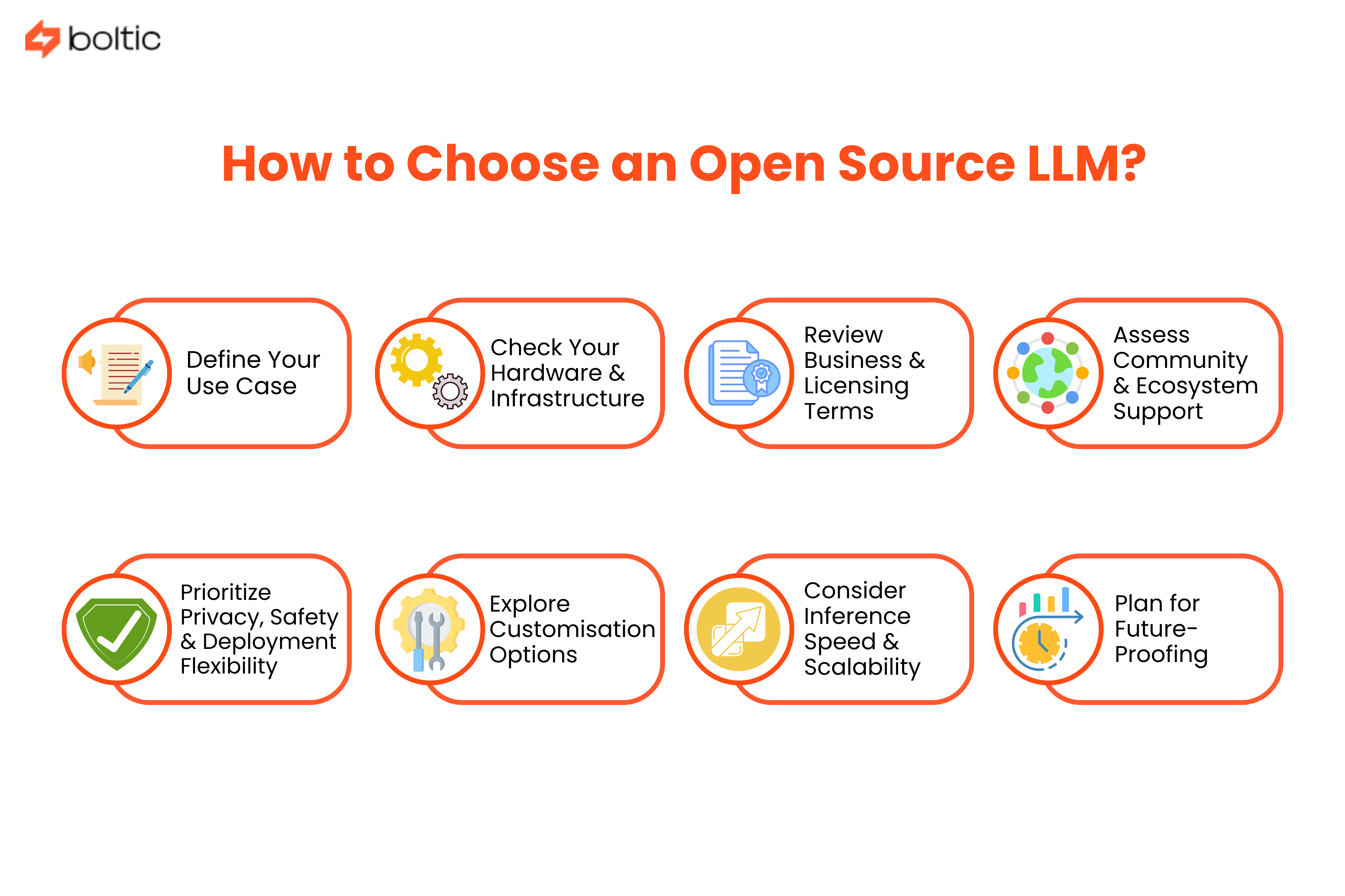The open source LLM (large language model) is the definitive category in generative AI. With tens of thousands of options available, it can become confusing to choose one especially when models specialise in different tasks. In this article, we’ll learn what is open source LLM is, evaluate the top 10 models and understand their pros and cons.
What is an Open Source LLM?
Open source LLMs are fully accessible for anyone to use, modify, and distribute (although some models require prior approval to use, and some might restrict commercial use of the model). This transparency allows for extensive customization and examination, enabling users to adapt the models to their needs. Open source models offer more freedom, often requiring less financial investment and enabling users to mitigate vendor lock-in risks.
An open source large language model (LLM) is a language model that can be used and modified by anyone under open licenses. This transparency allows for customization, enabling users to adapt the models to their needs. Open source LLMs give teams freedom over data, often require less financial investment costs and help users to mitigate vendor lock-in risks.
Top 10 Open Source Large Language Models (LLMs)

Pros and Cons of Open Source LLMs
Given below is a quick look at the pros and cons of each tool mentioned above:
LLaMA 3:
Designed for strong reasoning and fast performance, this is a high performance open-source LLM by Meta.
Pros
- Light-weight and runs fast
- Can be easily fine-tuned for custom tasks
Cons
- Less filtered compared to closed models
- Requires powerful hardware to run larger versions
Mistral:
This is an open source LLM built for speed as well as efficiency, Can easily be run on small computing power.
Pros
- Quite fast and lightweight
- Easy to deploy
Cons
- In comparison to bigger players, community ecosystem is still growing
- Lacks the ability to reason deeply
Falcon:
It is known for its balanced performance and efficient training architecture.
Pros
- Optimal for research
- Designed for speed
Cons
- Not quite advanced in comparison to newer open-source models
- Complex reasoning might be a struggle for smaller variants
BLOOM:
It is designed to generate text in 46 languages and 13 programming languages.
Pros
- Is able to handle multi-lingual content well & supports many languages
- Flexible for research purposes
Cons
- Sometimes the results take long
- Requires strong and large hardware
GPT-J / GPT-NeoX:
It can adapt to custom needs and generates text across tasks.
Pros
- Developer-friendly
- Active community support
Cons
- Large models need strong hardware
- Little behind in reasoning and accuracy
Gemma 2:
An easy to deploy and lightweight open source model from Google that is built to carry out heavy AI tasks.
Pros
- Cost-effective
- Designed to run on less computing power
Cons
- The model is hard to optimise for specific applications.
OLMo:
This is an open source model based on transparency and reproducibility.
Pros
- Optimal for intensive research and experiments
- Designed for educational purposes
Cons
- Not meant for heavy production use or large businesses.
- May lag during certain tasks
DBRX:
It is a big open model with 132B parameters that can be used for language modelling tasks on a large scale.
Pros
- Excellent reasoning performance
- Outperforms many other open‑source models
Cons
- Architecture still demands significant hardware
- Hardware costs are high
Command R:
Open model that works best for conversational AI, retrieval-augmented generation (RAG) and dialogues.
Pros
- Free to use. Works with chatbots and RAG
- Excellent performance in enterprise‑scale tasks
Cons
- There aren't as many pretrained fine-tuned versions available as yet
- Large versions still demand significant hardware to deploy
Mixtral:
Smaller versions of parameters are available that can work on less powerful hardware.
Pros
- Inexpensive
- Simple to set up
Cons
- The benchmark scores might not be as high as those of the best models.
- Slower inference
Advantages and disadvantages of using open-source LLMs
The main benefits of open source LLMs are:
- Helps you save money: Open source LLMs tend to be free or significantly cheaper than proprietary models because they don't have to pay for licenses or expensive API usage costs.
- Flexibility: You can change or adapt the model to fit the tasks that are unique to your domain and write any code you want. It isn’t possible with proprietary LLMs.
- Transparency: When you can see the model's underlying architecture, it makes audits easier and helps to build trust.
- Data Privacy and Security: You have full control over sensitive data and compliance when you host the models on your own servers. This is very important for government and businesse sectors.
- Deployment Control: You can use open source LLMs on almost any device, such as public clouds and private servers.
Limitations
- Comes with a higher maintenance burden: It requires technical knowledge to keep the infrastructure up to date, safe and well-maintained.
- Costs and Resource Needs: In order to run big LLMs on personal computing devices, powerful hardware is required. Businesses need to pay more in order to have access to these kinds of resources.
- Performance Gaps: Proprietary models are often better at complex tasks since they have access to bigger datasets and better quality systems. Although open source models are rapidly bridging the gap between them, there is a possibility that they might not be able to do certain functions well such as reasoning, handling multiple languages and supporting multiple modes of communication.
- Has fewer built-in tools and plug-and-play options: It is simple to add strong supporting software like plugins, agents and RAG modules to closed ecosystems. Adding strong supporting software like plugins, agents and RAG modules to closed ecosystems is simple. You might have to put all of these components together or develop them yourself when you use open source, which makes things more difficult.
- Concerns about security: It can become a major issue if the model isn't properly managed or kept up to date. You are in charge of keeping it safe from bugs, data leaks and compliance failures, all of which are risks.
- Support that isn't always there: Community support is great, but it can't replace the dedicated technical support or SLAs that proprietary vendors offer. For apps that are very important to the objective, this could be an important thing to ponder about.
Open source LLMs are excellent when you need to customise, comply with the rules, maintain your privacy and try novel approaches, but you should think carefully about maintenance, security, performance and support. They aren't a one-size-fits-all solution, but they're becoming more popular in the AI world because they are flexible, cheap and clear.
How to Choose an Open Source LLM?

Here is an overview of how to pick the right yet best open source LLM for your needs:
- Define your use case: List the main tasks you want the open source LLM. It's easier to pick the right LLM and get better results if you clearly state your goals.
- Check your hardware and infrastructure: It is expensive and difficult to deploy large models because they need higher GPU/TPU memory and processing power. Boltic.io platform works with a number of open source LLMs and may evolve with your needs.
- Business and Licensing: Ensure the LLM's licence is suitable for how you plan to use it.
- Community and Ecosystem support: Models with active communities and support networks provide you with plugins, updates and documentation.
- Flexibility in Deployment: If you care about data privacy, look into models that you can use on your own or in the cloud. Open source LLMs give you this freedom and Boltic.io's integrations help you simplify your workflows.
- Future-proofing: The modular platform from Boltic.io makes it easy to keep adding new features and upgrades without any issue.
What is the best open-source LLM?
There isn't one best open source LLM that works for everyone. The most suitable solution for you will depend on your specific needs. For example, the LLaMA 3 series models offer advanced reasoning and support for multiple languages. However, they need more resources to run. Other individuals may choose models like the Mistral family because due to it being cost-effective and easily deployable.
In the end, the best pen source LLM is the one that you can consistently fine-tune and keep up with on your own infrastructure.
Boltic.io: Integrate and Automate With open Source LLMs
Boltic.io is a platform that makes it easy to connect and automate open source LLMs. It provides businesses with the tools they need to get the most out of AI-driven workflows. Users can easily connect different open source large language models to their existing data sources, enterprise tools and apps using Boltic's no-code interface. The platform lets you fine-tune and improve LLMs with private data making sure that AI models give you relevant and domain specific insights.
drives valuable insights
Organize your big data operations with a free forever plan
An agentic platform revolutionizing workflow management and automation through AI-driven solutions. It enables seamless tool integration, real-time decision-making, and enhanced productivity
Here’s what we do in the meeting:
- Experience Boltic's features firsthand.
- Learn how to automate your data workflows.
- Get answers to your specific questions.








